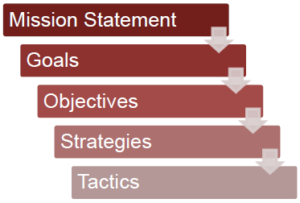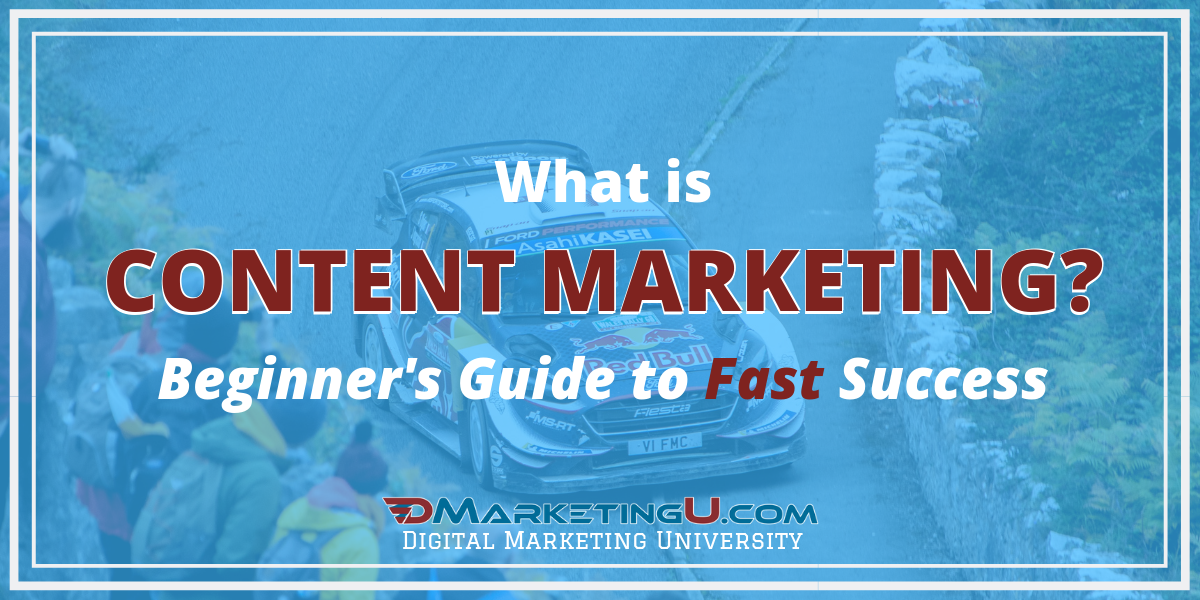
What is Content Marketing? A Beginner’s Guide to Fast Success
Imagine if our world was filled with pushy salespeople telling you about their products—located in every store, digitally popping up on websites and in apps, and even knocking on your front door. That negative impression in your head is the opposite of what you want to achieve with Content Marketing.
Welcome to a Beginner’s Guide to Fast Success with Content Marketing! In this guide, you’ll learn how to use Content Marketing to build a positive impression with prospects and customers by using storytelling along with multimedia that enhances the users’ experience. All of this will ultimately result in MORE sales leads, revenue, loyal customers and positive reviews.
LESSON 1: DEFINITION OF CONTENT MARKETING
Begin your journey with a review of three key terms below.
CONTENT: Creative assets developed to educate, inspire, entertain or convince a prospect or customer about an idea.
CONTENT SOURCES: The five different sources of creative assets include the common formats of text (written), audio (spoken), photo (captured), graphic (designed), video (recorded). Content is created using one of more of these sources.
CONTENT MARKETING: The use of creative assets to achieve an organizational Marketing goal related to promoting and selling your products and services, enhancing a positive impression of your brand (corporate or product reputation) or building loyalty and trust with your audiences.
Other definitions of Content Marketing:
Content Marketing is a strategic marketing approach focused on creating and distributing valuable, relevant, and consistent content to attract and retain a clearly defined audience — and, ultimately, to drive profitable customer action.” – Content Marketing Institute
Content Marketing is a strategic marketing technique that aligns business and consumer information needs with relevant content. Content can act as a means to attract, engage and convert a specific targeted audience. From blogging and social media to white papers and eBooks, marketers use a variety of content marketing tactics to consistently inform and persuade their customers–without trying to sell them something outright.” – TopRank Marketing
FAST SUCCESS TIP: Your content should always build trust in order to create and nurture long-term relationships. Trust is built with quality, accuracy, honesty and consistency in your content marketing.
Your content should always build trust in order to create and nurture long-term relationships. Trust is built with quality, accuracy, honesty and consistency in your #ContentMarketing. Share on XLESSON 2: GETTING STARTED
Whether you’re a new business owner, student, or just entering the field as a content marketer, the best place to start is by understanding the big picture of Content Marketing.
One major concept is not to focus on what you like, but rather build your strategies, processes and content around solving the problems of your prospects, buyers and users—also called your target audiences. When you focus on solutions to their problems and build stories about how you understand their challenges and can solve their problems, they will listen.
My recommendation on where to get started is with this process:
- Learn about Content Strategic Planning. (Lesson 3)
- Discover the process of Content Creation and resources available. (Lesson 4)
- Acquire knowledge about Content Publishing and become competent in Content Promotion. (Lesson 5)
- Understand how Content Monitoring works and reporting results. (Lesson 6)
- Familiarize yourself with Content Optimization to save time, money and resources by reusing existing content. (Lesson 7)
- Learn how to put everything together in a Content Marketing Plan. (Lesson 8)
Keep reading and you’ll learn all of these concepts in the upcoming lessons!
FAST SUCCESS TIP: If you’re a visual learner, search Google for a content marketing term then add “+infographic” to your search to find popular information graphics that explain complex concepts with visual storytelling. Here’s an example of the history of content marketing:
Source: Content Marketing Institute
LESSON 3: CONTENT STRATEGIC PLANNING
In this beginner’s guide, we’ll focus on the three foundational building blocks that an organization needs for a strategic plan before they can start creating and marketing content. Why is this foundation important? Content created without planning is less likely to meet the needs of the target audience, thus wasting your resources. Content Marketing is about investing your resources to meet and exceeds your goals, and spending time conducting strategic planning mitigates the risk of failure.
Proper content planning involves (A) creating a Content Marketing Mission Statement, (B) conducting an Audience Analysis, and (C) creating Goals, Objectives, Strategies and Tactics.
Lesson 3A: Content Marketing Mission Statement
The leaders of an organization should always create a corporate mission statement—which is an inspirational vision about the organization’s core purpose. For a marketing team, it must have a Content Marketing Mission Statement—which is an inspirational vision about the purpose and benefits of the content created for the target audiences.
Here’s an example of a Content Marketing Mission Statement from the DMarketingU Blog:
Our blog is where Digital Marketers find valuable resources and training to help them take action and get better results from their marketing channels and campaigns!
This statement is critical because it’s the inspiration for every new creative asset that the team plans, creates and promotes. It’s reviewed at the beginning of the planning process and a motto for the content creation team.
Lesson 3B: Audience Analysis
An organization’s audience cannot be “everyone”, even though I’ve had marketing clients tell me that statement before. Content Strategic Planning involves the skill of identifying your target audiences—segments of the larger audience that are most likely to become buyers or users.
How do you identify prospects as potential buyers or users? The simple answer is data, observations, interviews, insights and competitive research. In an ongoing process, content marketers gather data from sources such as website analytics, survey results, industry reports, market research, client interviews, customer service feedback, mouse-tracking or eye-tracking heatmaps, knowledge from the sales team, and research of competitors’ marketing efforts.
The result is the development of buyer personas—customized profiles of your ideal customers including their purchasing decision factors, needs, behaviors, attitudes, and demographic data—and the creation of user personas—customized profiles of your ideal users including their habits, skills, beliefs, attitudes and demographic data.
With these personas as marketing tools, you can design customized content to match their needs or hyper-target a marketing campaign ad on Google or Facebook to only display for users matching the factors that you’ve identified—which will save your advertising dollars because targeted ads are more efficient than generic ads.
Lesson 3C: Goals, Objectives, Strategies and Tactics
The success of a Content Marketing team will greatly improve when they have direction, guidance and leadership that steer them toward achieving exceptional results. The tools to provide that guidance are a hierarchy of four types of planning statements:
- Goals are the broad outcomes of WHAT to achieve (without measurements).
- Objectives are children of goals, typically WHAT to achieve with a measurement plus time to reach the goal.
- Strategies are generic statements HOW to achieve the objectives.
- Tactics are specific actions on HOW to achieve the strategies and objectives.
From a recent survey, here are some of the most common goals that marketers achieved using content marketing:
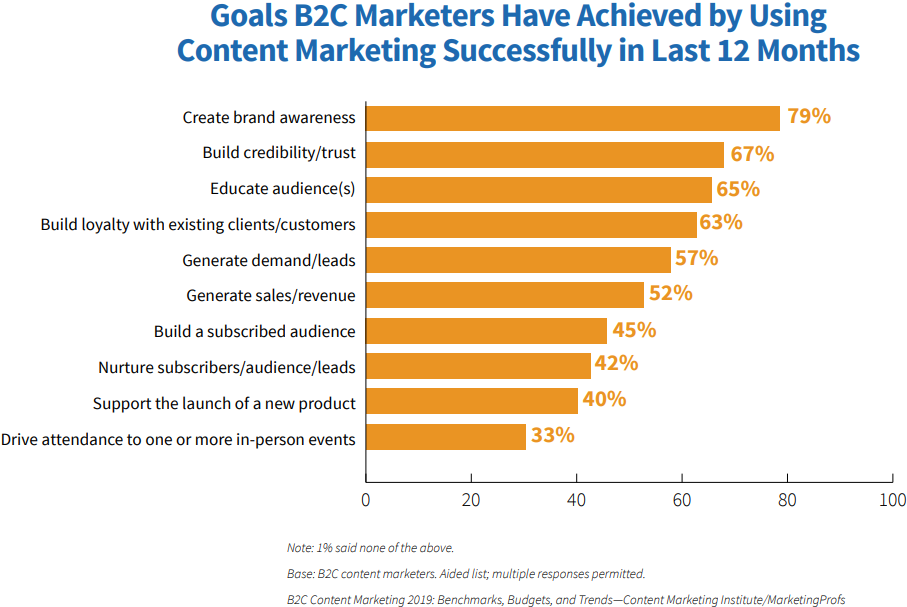
Here’s an example of how your goals, objectives, strategies and tactics work together:
- Goal (What): Increase Engagement on Social Media
- Objective (What): Increase engagement on our Facebook page to exceed 300 comments per month by the end of next fiscal quarter
- Strategy (How): Create engaging content that leads to thought leadership discussions
- Tactic #1 (How): Create a weekly Facebook Live video that asks for fans’ feedback on what works for them regarding a topic
- Tactic #2 (How): Create a fill-in-the-blank Facebook post on a popular user problem each week
When you look at the hierarchy, each Goal can have one or more Objectives. Furthermore, each Objective can have one or more Strategies. And, finally each Strategy typically has multiple Tactics as action items.
FAST SUCCESS TIP: “Every minute you spend in planning saves 10 minutes in execution; this gives you a 1,000 percent Return on Energy!” – Brian Tracy
LESSON 4: CONTENT CREATION
Once you know your target audiences’ needs for information to help solve their problems or retain them as a customer, you can begin to plan the process for Content Creation.
In order to build an effective creative asset for content marketing, here’s the 11-stage Content Creation Workflow that we use at DMarketingU:
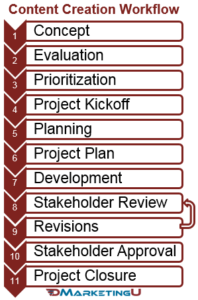 In stage 1, start brainstorming concepts based on either a marketing goal that you want to achieve or because you identified a customer’s problem to help solve.
In stage 1, start brainstorming concepts based on either a marketing goal that you want to achieve or because you identified a customer’s problem to help solve.
In stage 2, review the best concepts and evaluate them based on your own decision criteria for your organization.
In stage 3, approved concepts enter the development queue and are prioritized based on your own decision criteria.
In stage 4, when a concept reaches the top of the queue, it transforms to a project that requires a kickoff meeting that gathers the key team players and client (internal or external) to discuss the project goals, requirements, resources and challenges.
In stage 5, the project manager and the content creation team members begin the planning process of asking critical questions about the risks, challenges, tasks, budget and schedule.
In stage 6, the project manager creates a project plan that contains all of the project steps, roles, deadlines, assignments and risks.
In stage 7, the content creation team begins the development of their objects for the new content. This could involve copywriters, graphic designers, photographers, videographers and audio editors.
In stage 8, the main client that requested the content and other decision makers (collectively called “stakeholders”) will conduct a Stakeholder Review to compare this version of the content against the requirements and their expectations. The result of the review is a list of change requests—objects within the content that need to be added, changed or removed.
In stage 9, the project manager reviews the changes requests and approves the appropriate ones, which are then assigned to the content creation team to make revisions to the previous work.
In stage 10, the Stakeholder Approval can only occur after the repeated process loop of feedback and revisions finally results in no new approved change requests. At that point, the client signs off on the final version.
In stage 11, the content creation team saves the final version of the content where it can be accessed by the client and the project manager closes all the project management tasks and completes all paperwork.
Regarding popular content creation tools, Adobe makes a bunch of great paid tools but I’d recommend starting with some free alternatives listed in this graphic by Patreon:
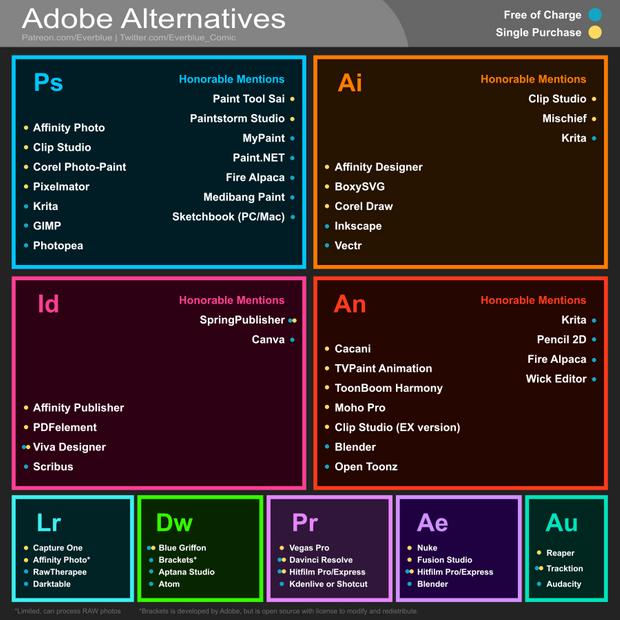
ADOBE PRODUCT LEGEND:
- Ps (Photoshop) for image creation
- Ai (Illustrator) for posters & logos
- Id (InDesign) for page layouts
- An (Animate) for animations
- Lr (Lightroom) for photo editing
- Dw (Dreamweaver) for website development
- Ae (After Effects) for video effects
- Pr (Premiere) for film editing
- Au (Audition) for audio editing
FAST SUCCESS TIP: If you’re on a budget, try outsourcing a project to a freelancer on Fiverr.com, where basic tasks start at $5 from content creators around the globe.
LESSON 5: CONTENT PUBLISHING AND CONTENT PROMOTION
Once your content is created, the next step is to take actions to help it reach your target audiences. The action of posting a piece of content publicly on one of your digital marketing channels, commonly your blog, is considered content publishing. When you share the details and unique URL of published content to an email list of top prospects or post it on Facebook, those actions are considered content promotion.
One of the best practices after creating your original content is to publish it on a digital marketing channel that you fully own and control, such as your blog or website. This is commonly called your content hub.
You don’t “own” your Facebook fan page since their algorithms control who sees your posts, not you. Therefore, it’s best to publish content on your content hub, then promote it to social networks and other marketing channels that you don’t control and drive traffic back to your owned asset. This method is called the Hub & Spoke Model, since the connection between a marketing channel and the content hub is similar to a spoke on a bicycle tire.
Whether you’re a beginner or experienced, one of the most difficult challenges is promoting your content and reaching your audience. No one can claim to be an expert or guru because the playing field is constantly changing. Facebook changes its news feed algorithm… Google changes how it displays search results… customers install protection against promotional email and browser ads. So, what works?
My recommendation is to focus on these content promotion skills as a beginner:
- Copywriting: Learn how to write exceptional titles and email subject lines. Buffer’s Kevan Lee has a great article on 30+ Ultimate Headline Formulas that I refer to often.
- Video Editing: Most audiences respond well to quick video promotions, and your competition is doing it. Therefore, learn video editing on phone apps like iMovie (iOS) or Adobe Premiere Clip (Android) or try an open source (free) desktop program.
- Email List Building: You can never learn too much in this field because email is still an amazing one-to-one marketing tool. So, ethically acquiring email addresses from your prospects and customers is a gold mine. The larger your email list, the more people you can promote to with your new content.
- Paid Promotion: On most social networks, it’s now pay-to-play if you want to reach your followers and acquire new ones. Watch YouTube videos or find free training on how to build a Facebook ad and create a custom audience based on targeting factors that you discovered Lesson 3B.
FAST SUCCESS TIP: Instead of writing one post for all social networks, write customized posts tailored for the unique traits of of each network. A quick overview is to be more authentic and friendly on Facebook, professional and brief on LinkedIn, informative and brief on Twitter, and entertaining and interesting on Instagram.
LESSON 6: CONTENT MONITORING & REPORTING
In the field of Content Marketing, listening and observing is often times the most important skill for success. From beginners to experts in the field, we all rely on conducting experiments and learning from our failures.
To discover your failures and recognize opportunities, you must learn how to monitor the performance of your marketing actions, analyze user behaviors and data, then convert data to information that can be used for decision making and improvements.
As a beginner, my recommendation is to get to know Google Analytics for monitoring your website traffic and built-in analytics provided free by social networks. Read the training guides that I’ve curated below and setup your own account on each platform to try some hands-on features.
- Google Analytics training (via Google)
- Facebook Insights guide (via Neil Patel)
- Twitter Analytics guide (via Buffer)
- Instagram Insights guide (via HubSpot)
- LinkedIn Analytics guide (via Hootsuite)
- Pinterest Analytics help (via Pinterest)
- YouTube Analytics guide (via Single Grain)
To measure your success with Content Marketing, each data point that’s important to your decision making is commonly called a Key Performance Indicator, or KPI. Tracking engagement factors such as Likes is nice, but to become more advanced with analytics, here are “18 Social Media KPI’s You Need to Track to Measure Success” via Hootsuite, plus their cheatsheet below.
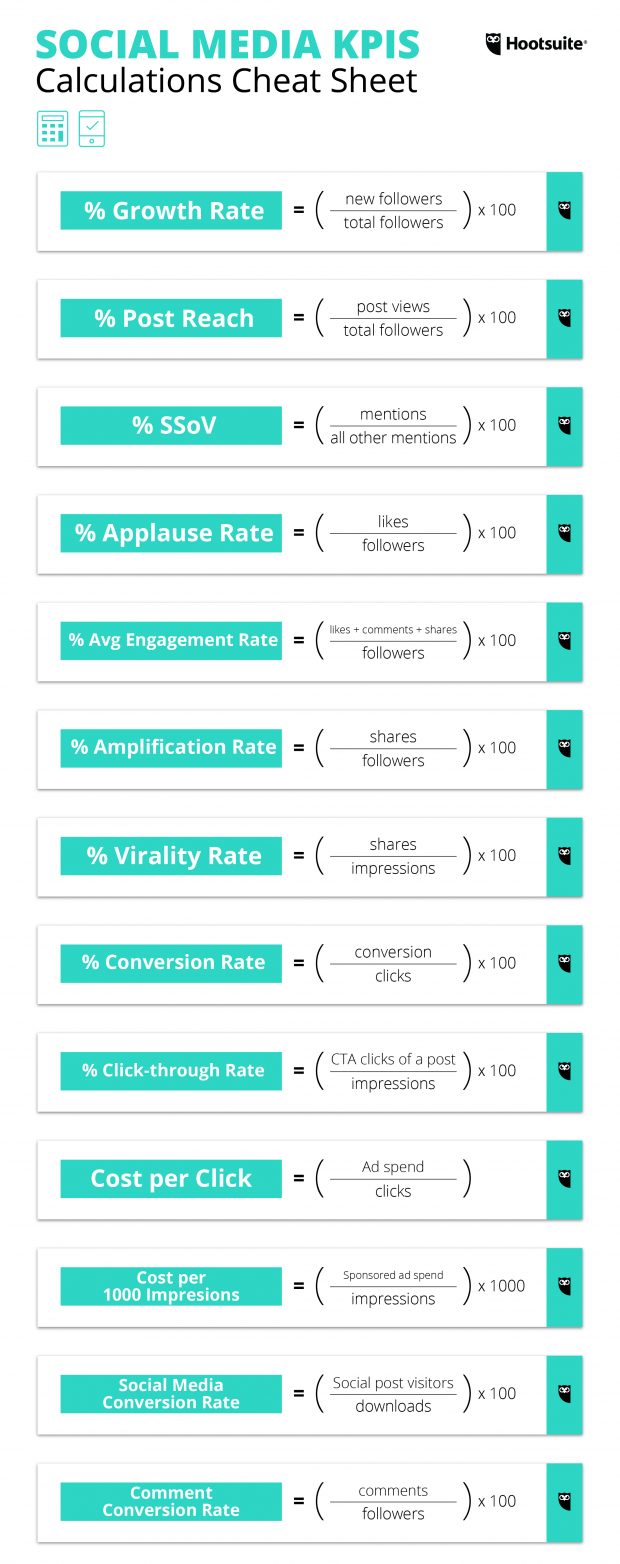
In addition to social media KPIs, other Content Marketing aspects to measure include tracking “conversions”, or actions that a user takes to achieve a marketing goal. A few examples of conversions include watching a video, downloading a PDF, filling out an online form, subscribing to your newsletter, purchasing a product or any action that a user takes to get closer to solving their problems or fulfilling one of your marketing goals.
Once you start identifying the conversion steps that you want users to complete, the next step is to try to improve that action’s success rate, also known as the conversion rate. For example, if 10 users click a link in an email but 100 users opened the email and saw the link, the conversion rate is 10%. The science of experimentation to improve that rate is called conversion rate optimization (CRO). As a learning resource, you can start with CrazyEgg’s CRO Guide.
FAST SUCCESS TIP: Rather than focusing on your number of Likes and Followers, spend time tracking your conversion rates that directly relate to lead generation and revenue generation. Always be experimenting with better ways (new button color, better headlines, higher quality content, easier forms) to get more leads and sales.
Rather than focusing on your number of Likes and Followers, spend time tracking your conversion rates that directly relate to lead generation and revenue generation. Share on XLESSON 7: CONTENT OPTIMIZATION
Once a piece of content is created, it becomes an organizational asset that can be manipulated to help you gain or save money in the future. Previously in Lesson 6, you learned about conversion rate optimization, but now you’ll learn how to optimize your content for additional returns on the cost of its development.
Content optimization is the process of identifying opportunities for increased engagement, cost savings, time savings or higher ROI from existing content, digital assets and marketing processes.
The two areas that will benefit you the most as a beginner are learning about (A) Content Optimization Experiments and (B) Repurposing Content.
- Content Optimization Experiments: The goal of an experiment is to find a way to improve the performance of a content asset. If users sign up for your newsletter on a landing page at a 10% conversion rate (1 user / 10 visitors), conduct experiments to try to boost it to 15% conversion rate. Get started by exploring Neil Patel’s “100 Conversion Optimization Case Studies” and discover some amazing tricks!
- Repurposing Content: The act of repurposing content is to transform it from its original use to other mediums. The most versatile form of content is video, since its audio can be stripped into an MP3 format or transcribed into text format, plus the video frames can be captured into photos, or the full video can be spliced into clips. By reusing the original content for a new purpose, you’re saving content creation costs while getting new value from the previous investment in its development.
FAST SUCCESS TIP: Since video is versatile and audiences love videos, always try to either start your content creation with a video or plan for the other medium to be converted to video. For example, if you create a blog post as the original content, you can use a screen capture program and a microphone to scroll through the post with a voice-over describing the post to create a valuable video.
LESSON 8: CONTENT MARKETING STRATEGIC PLAN
The ultimate skill in Content Marketing is the ability to develop a strategic plan to provide leadership and guidance for your organization. For my digital marketing clients that are startups or small businesses, I always recommend writing a traditional business plan AND a content marketing plan.
The benefits of a content marketing plan include:
- Guidance and clear direction from your Goals, Objectives, Strategies and Tactics.
- An in-depth understanding of your prospects, buyers and users that will make you with better at targeting and customizing content.
- Cost and time efficiencies with content creation because of a standardized project workflows and procedures.
- Achieve better results from marketing campaigns due to better content, strategic planning, and efficient publishing and promoting of the content.
- Continuous improvements will be achieved from content optimization techniques and repurposing of content, resulting is higher ROI (return on investment) from your content.
A recent study found that only 37% of marketers had a documented content marketing strategy… that’s 63% that are missing a tremendous opportunity for improvements! As a beginner, you can add value to any organization by learning the first 7 lessons from this course, then documenting the processes and best practices into a strategic plan.
FAST SUCCESS TIP: If you need to create a documented professional strategic plan for your organization, you can avoid spending thousands of dollars on a consultant or endless hours researching many websites. The best option is to use a proven step-by-step system like our online course and training videos called “How to Create a Content Marketing Plan: 12-Step System to Success“. Empower yourself with knowledge from our course to get results quickly.
YOUR NEXT STEPS
What do you want to achieve with content marketing? You can become a jack-of-all-trades or a specialist in one category. Here are some options:
- If you’re a “planner“, focus on project management skills from the PMBOK (Project Management Body of Knowledge).
- If you’re a “maker“, you can start with free training on YouTube about copywriting, blogging, graphic design, photography or videography.
- If you’re an “experimenter“, study conversion rate optimization (CRO) techniques and software to help an organization make improvements.
- If you’re a “data monkey” like me, learn Google Analytics and each social network’s built-in analytics system.
As my final piece of advice… never stop learning! Continuously explore advice from multiple sources. As a starting point, here are a few of my Top Content Marketing Experts to Follow on Twitter:
- ANN HANDLEY – Head of Content at MarketingProfs
- JAY BAER – Founder of digital marketing consultancy
- JEFF BULLAS – Global Content Marketing Influencer
- JOE PULIZZI – Founder Content Marketing Institute and #CMWorld
- LILACH BULLOCK – Content Marketing & Social Media Specialist
- MARK SCHAEFER – Author, speaker, marketing strategist
- MICHAEL STELZNER – Founder of Social Media Examiner
- NEIL PATEL – Co-founder of Neil Patel Digital
- PAT FLYNN – CEO; Host of “The Smart Passive Income Podcast”
- RANDY EVERETT – Founder of Digital Marketing University
- Find more in this list of Top 100 Content Marketers
RELATED RESOURCES
In addition to this Beginner’s Guide to Fast Success with Content Marketing, I’ve curated some of my favorite resources that I’ve shared with my clients and peers:
- Moz: Beginner’s Guide to Content Marketing
- HubSpot: Ultimate Content Creation Guide
- Heidi Cohen: Content Marketing Optimization Guide
- DMarketingU: How to Create a Content Marketing Plan online course
CONCLUSION
By learning the basic concepts of Content Marketing, you will ultimately discover how to help an organization gain MORE sales leads, revenue, loyal customers and positive reviews with high-quality content.
Start your journey by studying Content Strategic Planning. (Lesson 3) Next, discover the process of Content Creation. (Lesson 4) Then, acquire knowledge about Content Publishing and become competent in Content Promotion. (Lesson 5) Continue with understand how Content Monitoring works and reporting results. (Lesson 6) Afterwards, familiarize yourself with Content Optimization to save time, money and resources by reusing existing content. (Lesson 7) Finally, learn how to put everything together in a Content Marketing Plan. (Lesson 8)
In addition to the resource links provided throughout the article, what are your favorite Content Marketing resources to share with beginners? Please let you feedback in the Comments section below.


